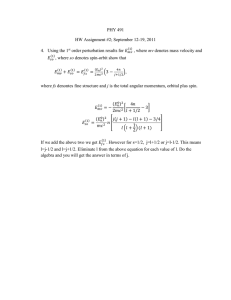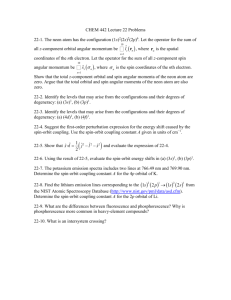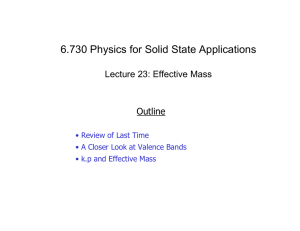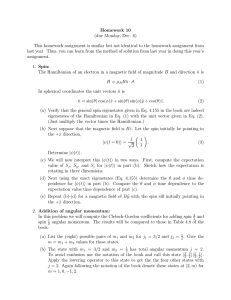Magnetism in Transition Metal Complexes
advertisement
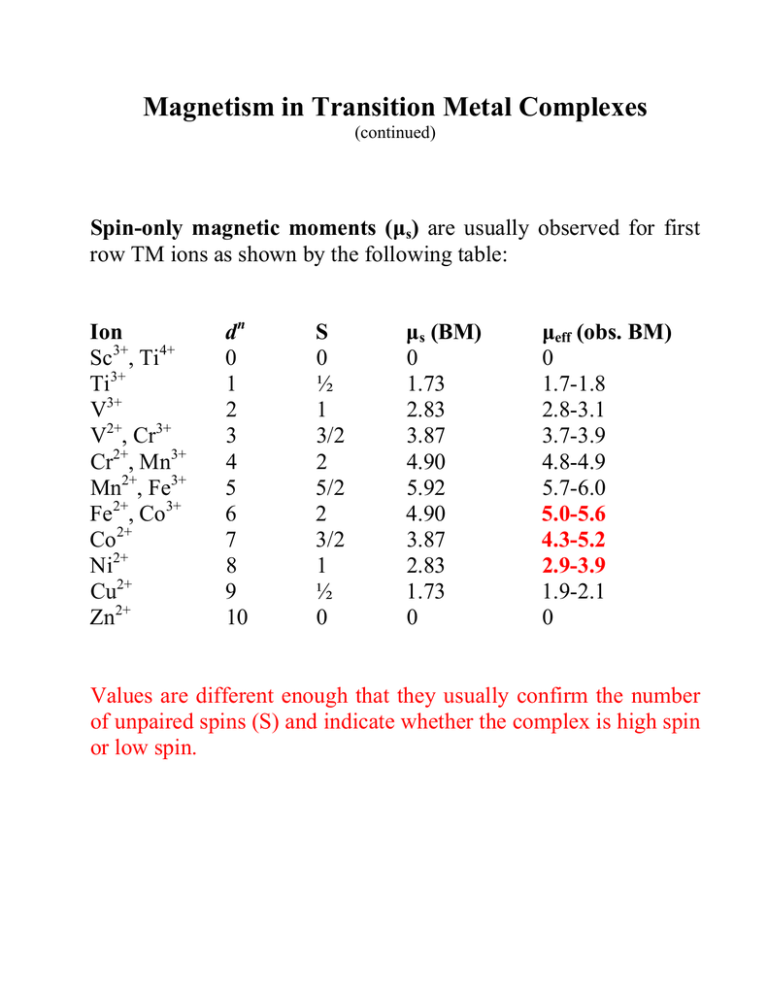
Magnetism in Transition Metal Complexes (continued) Spin-only magnetic moments (µs) are usually observed for first row TM ions as shown by the following table: Ion Sc3+, Ti4+ Ti3+ V3+ V2+, Cr3+ Cr2+, Mn3+ Mn2+, Fe3+ Fe2+, Co3+ Co2+ Ni2+ Cu2+ Zn2+ dn 0 1 2 3 4 5 6 7 8 9 10 S 0 ½ 1 3/2 2 5/2 2 3/2 1 ½ 0 µs (BM) 0 1.73 2.83 3.87 4.90 5.92 4.90 3.87 2.83 1.73 0 µeff (obs. BM) 0 1.7-1.8 2.8-3.1 3.7-3.9 4.8-4.9 5.7-6.0 5.0-5.6 4.3-5.2 2.9-3.9 1.9-2.1 0 Values are different enough that they usually confirm the number of unpaired spins (S) and indicate whether the complex is high spin or low spin. Deviations are caused by two factors: (a) orbital angular momentum (L) contributions to µ in cases where orbital angular momentum is not quenched a somewhat more elaborate expression for µ applies: µLS = [4S(S+1) + L(L+1)]1/2 which obviously simplifies to the µs expression if L = 0 If L ≠ 0 then µLS > µS NOTE one special case: for a 6S ground state, L = 0 so µeff = µs Ion dn S Fe2+, Co3+ Co2+ Ni2+ 6 7 8 2 2 3/2 3 1 3 L* GS term µS 5 T2g T1g 3 A2g 4 4.90 3.87 2.83 µLS µeff 5.48 5.20 4.47 5.0-5.6 4.3-5.2 2.9-3.9 * in an Oh complex • orbital angular momentum is NOT quenched in degenerate ground states (especially T) so there is a significant contribution from L (egs. Co2+ and Co3+, Fe2+ above) • non-degenerate ground states do not have a contribution from L so values close to the spin only moment are usually found (eg. Ni2+) (b) contributions from spin-orbit coupling • Spin-orbit coupling means that S and L do not operate independently and J states need to be defined. • Since spin-orbit coupling is usually small for lighter transition metals, we can treat S and L independently (as was done in the earlier equation for µLS) • This isn’t true for heavy metals and their magnetism is MUCH more complicated to predict. Temperature effects on µeff Curie Law predicts µ should be T independent but that is often NOT the case: • orbital angular momentum and spin-orbit effects can come into play • magnetic moment is determined by the L and S contributions (plus spin-orbit effects) of ALL populated levels weighted by their populations so if other thermally accessible states exists, their population will change with T and so will their contribution • if there is any long range magnetic ordering (i.e. not behaving as isolated paramagnets) then µ will vary because these effects are T dependent... Magnetic ordering: bulk properties • direct effect of adjacent spins OR • transmitted through bridging ligands Ferromagnetism: neighbouring spins align parallel with one another below a certain critical temperature (Tc Curie temperature) • below Tc the material remains permanently spin aligned even when the field is removed • field dependent effect Antiferromagnetism: neighbouring spins align anti-parallel with one another below a certain critical temperature (TN Néel temperature) • below TN the material tends to remain spin aligned and has a lower moment than expected • common effect through bridging ligand due to ‘superexchange’ χ Tc TN ferromagnetic paramagnetic anti-ferromagnetic diamagnetic T (Figures courtesy of Robin Hicks)
